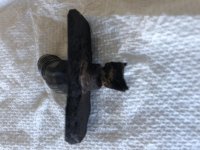Most of RV's have some form of smoke in the cockpit. Our best guess right now is most of it comes in thru the firewall.
We do not believe it comes in thru the flap hole, as a test we put tape on flaps in the full up position and flew with smoke, it got WORSE.
If an RV is built properly, the firewall should be pretty much 100% sealed.
The most common place for exhaust fumes, and or smoke to enter the cabin, is around the baggage bulkhead.
On some RVs, if you look closely in the area between the rudder and the vertical stabilizer, you can see some staining from exhaust.
The exhaust plume grows in diameter as it moves aft under the belly, and it closely follows the air flow on the bottom of the airplane. By the time it gets to the aft end of the fuselage, the plume has grown quite a bit and can be following the surface of the fuselage.
The air gets pretty disturbed at the far aft, and and flows in a lot of different directions
Now add the fact that the cockpit has a lot of curved shape surrounding it that produces low pressure on the outside. This often produces a leakage flow from inside the cockpit to the outside.
So, if there is an outward flow, there will always be an equal inward flow of make up air. That air can come from a lot of different locations, such as the flap push rod opening, the aileron push pull tube openings, and the tail cone.
My experience shows that the majority of the make up air is usually leaking in from the tail cone.
I have also learned that sealing the canopy really well so that there is no outflow does a lot to prevent exhaust and smoke from entering, and it greatly improves the cabin heat performance in the winter, because you are not allowing cold air to compete against the hot air from the cabin heat system.
Before anyone thinks that sealing up the path from the tail cone would be a good solution, keep in mind that there always has to be an out flow path if you want the fresh air vents, and the cabin heat to work well.
My recommendation is always to leave the openings in the baggage bulkhead open and work at sealing everywhere else in the cockpit. Especially outwardly curved areas of the canopy, which likely have reduced pressure on the outside.





